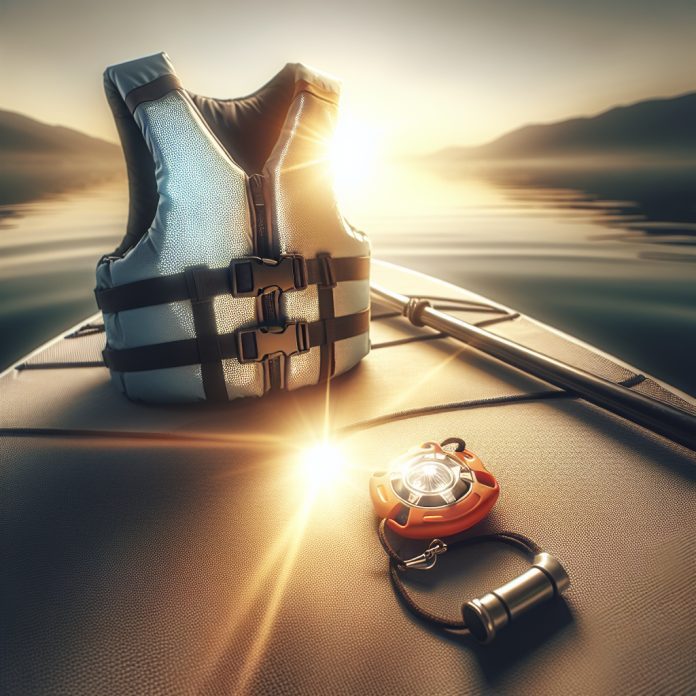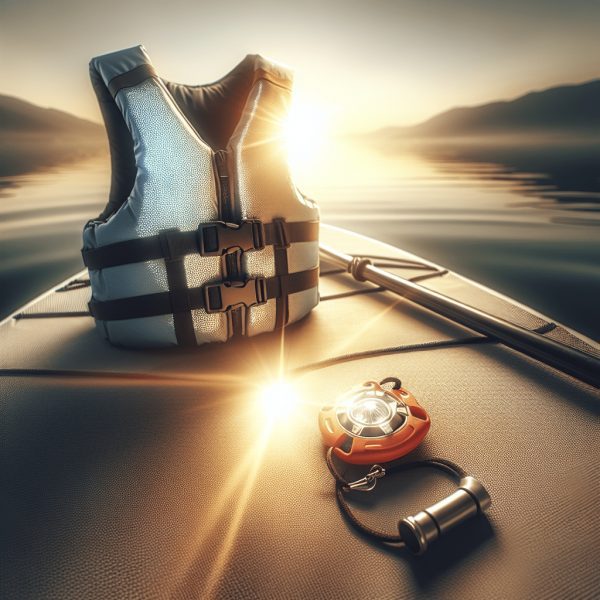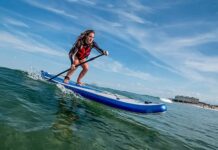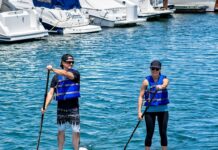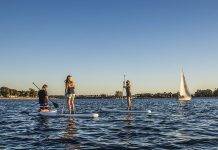In our article, we will explore invaluable tips and tricks to ensure your safety while engaging in the increasingly popular activity of SUP fitness paddling. From wearing the right gear to understanding your limits, we have rounded up all the essential information you need to make your next paddling session not only exhilarating but also worry-free. So, grab your board and paddle, and let’s dive into the world of safely navigating the waters while achieving your fitness goals!
Choosing the Right Equipment
Selecting a Suitable SUP Board
When it comes to SUP fitness paddling, choosing the right equipment is crucial for ensuring a safe and enjoyable experience on the water. The first step is selecting a suitable SUP board. Consider factors such as your weight, skill level, and the conditions you’ll be paddling in. A wider and longer board provides more stability, making it ideal for beginners or those looking to participate in fitness activities like yoga. On the other hand, a narrower and shorter board offers more maneuverability, which is beneficial for advanced paddlers or those looking to engage in faster-paced workouts.
Using the Correct Paddle
Equally important is using the correct paddle for your SUP fitness paddling. Paddles come in various materials, such as aluminum, fiberglass, and carbon fiber. While aluminum paddles are more affordable, they can be heavier and may cause fatigue during longer paddling sessions. On the other hand, fiberglass and carbon fiber paddles are lighter and more suitable for fitness activities as they reduce strain on your arms and shoulders. Additionally, the length of the paddle is important, and it should be approximately 6 to 10 inches taller than your height to ensure efficient paddling technique.
Wearing the Appropriate Gear
To stay safe while SUP fitness paddling, it is essential to wear the appropriate gear. This includes a personal flotation device (PFD), also known as a life jacket, to ensure you stay afloat in case of an accident. A PFD should be properly sized and fit snugly to your body. Additionally, consider wearing a leash, which attaches your SUP board to your ankle and helps prevent separation in case of a fall. Wearing comfortable and water-resistant clothing, such as a rash guard or wetsuit, is also recommended to protect your skin from sunburn and abrasions.
Knowing Your Environment
Researching the Paddling Location
Before heading out for a SUP fitness paddling session, it’s important to research the paddling location. Familiarize yourself with the area’s rules and regulations, such as any restrictions or permits required. Take note of any hazards in the area, such as submerged rocks or strong currents. It’s always a good idea to check if the location has any designated launch points and parking facilities. Becoming familiar with the layout of the area will help you plan your paddling route and ensure a smooth and safe experience.
Checking the Weather Conditions
Another crucial aspect of staying safe while SUP fitness paddling is checking the weather conditions. Keep an eye on the forecast for any changes in wind speed, wave height, or potential storms. Strong winds and rough waters can make paddling more challenging and increase the risk of accidents. If the weather conditions are not suitable, it’s best to reschedule your paddling session for a later time. Remember, it’s always better to be safe than sorry, and being aware of the weather conditions beforehand will help you avoid unnecessary risks.
Being Aware of the Water Traffic
Safety on the water also involves being aware of the water traffic in the area. Whether you’re paddling in a lake, river, or coastal area, there may be other watercraft sharing the same space. It’s important to familiarize yourself with the local regulations regarding right-of-way and give way to larger vessels whenever necessary. Always be alert and keep an eye out for approaching boats, kayaks, or jet skis. Maintaining a safe distance from other watercraft and avoiding crowded areas will help reduce the risk of collisions or other accidents while paddling.
Maintaining Proper Technique
Learning the Basic Paddling Strokes
To ensure an efficient and safe SUP fitness paddling experience, it’s essential to learn and practice the basic paddling strokes. The primary strokes include the forward stroke, backward stroke, sweep stroke, and draw stroke. Each stroke serves a specific purpose and helps with maneuverability, speed, and directional control. Taking the time to learn and perfect these strokes will not only enhance your overall paddling technique but also contribute to a safer and more enjoyable experience on the water.
Practicing Balance and Body Alignment
Maintaining balance and proper body alignment is crucial for staying safe while SUP fitness paddling. Good posture and a stable stance on your board will help you stay in control and reduce the risk of falling. Keep your feet shoulder-width apart and your knees slightly bent to maintain stability. Engage your core muscles for better balance and use your paddle as a stabilizing tool when needed. Regular practice and improving your core strength will enhance your stability and overall paddling performance.
Avoiding Overexertion and Fatigue
Overexertion and fatigue can be detrimental to your safety while SUP fitness paddling. It’s important to pace yourself and avoid pushing beyond your limits, especially if you’re a beginner or participating in intense workout sessions. Take breaks when needed and hydrate regularly to prevent dehydration. Listen to your body and recognize signs of fatigue, such as muscle cramps or heavy breathing. Pushing through exhaustion can lead to poor decision-making and increased risk of accidents. Prioritize your safety by knowing your limits and respecting them.
Ensuring Personal Safety
Wearing a Personal Flotation Device
One of the most important safety measures while SUP fitness paddling is wearing a personal flotation device (PFD). Even if you’re a confident swimmer, unexpected situations can arise where a PFD can save your life. Choose a PFD that is designed specifically for paddle sports, as they provide greater mobility and comfort. Ensure that the PFD is properly fastened and fits snugly to your body. Remember, your safety should always come first, and wearing a PFD is a simple yet effective way to protect yourself on the water.
Staying Hydrated and Nourished
Proper hydration and nutrition are vital for maintaining personal safety while SUP fitness paddling. Paddling can be a demanding physical activity, and it’s important to fuel your body adequately. Carry a sufficient supply of water and hydrate regularly, especially in hot and sunny conditions. Consider bringing snacks or energy bars to replenish your energy levels during longer paddling sessions. Staying hydrated and nourished will not only enhance your performance but also prevent fatigue and reduce the risk of accidents due to impaired judgment.
Using Sunscreen and Protection from UV Rays
When engaging in SUP fitness paddling, it’s essential to protect your skin from the harmful effects of the sun’s UV rays. Apply a broad-spectrum sunscreen with a high SPF before heading out on the water, and reapply as necessary to ensure continuous protection. Additionally, consider wearing a wide-brimmed hat and sunglasses to shield your face and eyes from direct sunlight. Remember, prolonged exposure to the sun without protection can lead to sunburn, heatstroke, and long-term skin damage. Prioritizing sun protection is a crucial aspect of staying safe and healthy while paddling.
Being Mindful of Potential Hazards
Being cautious of Rocks and Shallow Areas
When paddleboarding for fitness, it’s important to be cautious of rocks and shallow areas in the water. Submerged rocks can pose a significant risk of collision or damage to your SUP board. Always be vigilant and scan the water ahead for any signs of shallow areas or underwater obstacles. Familiarize yourself with the local topography of the area and any potential hazards. Avoid paddling too close to shorelines and be aware of any sudden changes in water depth. By being mindful of these potential hazards, you can minimize the risk of accidents and protect yourself and your equipment.
Watching out for Marine Wildlife
As you explore the waters during your SUP fitness paddling sessions, it’s important to be mindful of marine wildlife. Many bodies of water are home to various species, including fish, turtles, birds, and sometimes even dolphins or whales. While it’s an incredible experience to witness these creatures in their natural habitat, it’s crucial to maintain a safe distance and avoid disturbing their natural behavior. Observe and appreciate from afar, and do not attempt to touch or feed the wildlife. Respecting their space helps protect both you and the animals while enjoying your paddleboarding adventure.
Being Aware of Tides and Currents
Tides and currents can significantly impact your paddling experience and safety. It’s important to familiarize yourself with the local tide times and current patterns before embarking on a SUP fitness paddling session. High tides can make certain areas more challenging to navigate, while strong currents can significantly affect your speed and control. Plan your paddling route accordingly, taking into consideration the changing tide levels. It’s also advisable to check tide charts and current forecasts to ensure you paddle within your skill level and avoid any potential dangers associated with swift currents and rapidly changing water levels.
Seeking Professional Guidance
Taking SUP Fitness Lessons and Training
If you’re new to SUP fitness paddling or looking to enhance your skills, seeking professional guidance is highly recommended. Enroll in SUP fitness lessons or training programs conducted by experienced instructors. They will teach you proper paddling techniques, fitness routines, and provide invaluable tips for staying safe on the water. These experts can assess your abilities, provide personalized guidance, and help you progress at a comfortable pace. By investing in professional instruction, you’ll gain the knowledge and skills necessary to enjoy SUP fitness paddling to the fullest while minimizing the risk of accidents.
Consulting with Experienced Paddlers
In addition to professional instruction, consulting with experienced paddlers is another effective way to enhance safety while SUP fitness paddling. Seek advice from individuals who have extensive experience in paddleboarding and fitness activities on the water. They can offer insights into local paddling spots, share their tips and tricks, and provide guidance on staying safe in specific conditions. Engaging in conversations with these experienced paddlers will not only broaden your knowledge but also help you make informed decisions regarding equipment, techniques, and appropriate safety measures.
Joining a Paddling Group or Club
Joining a paddling group or club is an excellent way to enhance safety while fostering a sense of community among fellow paddlers. These groups often organize group paddles, training sessions, and social events where you can learn from experienced paddlers and exchange valuable tips and information. Being part of a paddling group allows you to paddle with others, increasing safety through numbers and mutual support. Additionally, such groups might have access to safety equipment, resources, and expert guidance that can further contribute to a safer SUP fitness paddling experience.
Knowing Your Limits
Start with Beginner-friendly Routes
When engaging in SUP fitness paddling, it’s important to start with beginner-friendly routes suited to your skill level. Choose routes with calm waters, minimal currents, and shorter distances. Gradually increase the challenge as you gain more experience and confidence. Pushing beyond your limits too soon can lead to frustration, exhaustion, and increased risk of accidents. By starting with easier routes and gradually progressing, you’ll be able to build your skills, endurance, and knowledge of the water, ensuring a safer and more enjoyable SUP fitness paddling experience.
Gradually Increase Difficulty and Distances
Once you’ve mastered beginner-friendly routes, it’s time to gradually increase the difficulty and distances of your paddling sessions. Challenge yourself with longer routes, more varied water conditions, and potentially stronger currents. Pushing your limits in a controlled and progressive manner will help you grow as a paddleboarder while minimizing the risks associated with sudden and extreme changes. Always assess the conditions and your capabilities before embarking on a more challenging paddling session, and remember to prioritize safety at all times.
Listening to Your Body for Signs of Exhaustion
Listening to your body is crucial for staying safe while engaging in SUP fitness paddling. Pay attention to signs of exhaustion, such as muscle fatigue, dizziness, or mental fog. When you start feeling these symptoms, it’s important to acknowledge them and take the necessary rest. Ignoring your body’s warning signs can lead to poor judgment, decreased coordination, and increased risk of accidents. Allow yourself plenty of time to recover, hydrate, and rest. By listening to your body and respecting its limits, you’ll be able to enjoy the sport safely and avoid unnecessary injuries or mishaps.
Paddling with a Buddy
Paddling with a Friend for Safety
Paddling with a buddy is a great way to ensure safety while enjoying SUP fitness paddling. Having a companion on the water provides an extra layer of security and immediate assistance in case of emergencies. They can help you navigate challenging conditions, share the workload during long paddles, and keep an eye out for potential hazards. When choosing a paddling buddy, consider their experience, fitness level, and ability to assist in an emergency. Remember to establish clear communication and agree on safety protocols before setting out on your paddleboarding adventure.
Establishing Communication Signals
Communication is key when paddling with a buddy. Establishing communication signals allows for effective coordination and ensures prompt response in case of emergencies or changing conditions. Agree on clear hand signals or verbal cues that indicate your intentions or alert your companion to potential dangers. Signals for “stop,” “go,” “danger,” and “help” can be helpful in maintaining a safe and coordinated paddle. Regularly check in with each other during the session to ensure both paddlers are comfortable and safe. By establishing effective communication, you’ll enhance safety and enjoy a seamless paddling experience.
Assisting Each Other in Case of Emergencies
While paddling with a buddy provides an additional layer of safety, it’s essential to be prepared to assist each other in case of emergencies. Practice rescue techniques and rehearse scenarios where one or both paddlers may need assistance. Learn how to safely tow a fellow paddler or perform self-rescue techniques. Familiarize yourselves with the proper procedures for helping someone back onto their SUP board after a fall. Being prepared to assist each other in case of emergencies will ensure a safer and more secure SUP fitness paddling experience.
Being Prepared for Emergencies
Carrying a Safety Whistle or Horn
Carrying a safety whistle or horn is a simple yet effective tool for alerting others to your presence or calling for help in case of emergencies. These compact and lightweight devices can be easily attached to your PFD or securely stored in a waterproof bag. By blowing the whistle or sounding the horn, you can attract the attention of nearby boaters or other paddlers. This can be especially helpful in situations where verbal communication may be challenging due to distance or noise. Make sure to practice using the whistle or horn beforehand to ensure familiarity and ease of use during emergencies.
Knowing Basic CPR and First Aid Skills
Having basic CPR and first aid skills is invaluable when it comes to ensuring personal safety while engaging in SUP fitness paddling. Accidents can happen, and being prepared to provide immediate assistance can make all the difference in saving a life. Enroll in a CPR and first aid course specifically tailored for water sports or paddleboarding. These courses will teach you essential skills such as CPR techniques, treating common injuries, and providing necessary care until professional help arrives. Remember to update your skills regularly and stay informed about any updates or changes in procedures.
Having Emergency Contact Information
Always carry emergency contact information with you while SUP fitness paddling. This should include the contact numbers of local emergency services, the nearest Coast Guard station, and any other relevant authorities or organizations. Store this information in a waterproof container or bag to ensure it remains accessible and visible during emergencies. Additionally, consider informing a trusted family member or friend about your paddling plans, including your intended route and estimated time of return. In case of any unforeseen circumstances, having emergency contact information readily available can expedite the response and help get you the assistance you need.
Regular Equipment Inspections
Checking the Integrity of your SUP Board
Regular equipment inspections are essential for maintaining safety while SUP fitness paddling. Before each paddling session, visually inspect your SUP board for any signs of damage or wear. Check for cracks, dents, or loose fittings that may affect the board’s integrity and stability. Pay special attention to the leash attachment point, fin box, and rail edges. Ensure that all components are securely attached and functioning properly. If you notice any significant damage or defects, it’s best to have them repaired or replaced before venturing out on the water. Regular inspections will help prevent equipment failure and enhance your safety on the water.
Inspecting the Paddle for Damage
In addition to inspecting the SUP board, it’s equally important to inspect your paddle for any signs of damage. Inspect the handle, shaft, and blade for cracks, bends, or loose parts. Give the paddle a gentle twist to check its overall rigidity and strength. Inspect the blade edges for any chips or signs of wear. If you notice any significant damage or defects, it’s advisable to replace the paddle to ensure a safe and effective stroke. Regularly cleaning and maintaining your paddle will help prolong its lifespan and enhance your paddling experience.
Maintaining Safety Equipment
Regular maintenance of your safety equipment is crucial to ensure its effectiveness when needed. This includes inspecting and testing your personal flotation device (PFD), whistle or horn, and any additional safety gear you carry. Check the straps, buckles, and inflating mechanisms of your PFD for any signs of wear or malfunction. Test your whistle or horn to ensure it produces a clear and audible sound. Inspect other safety equipment such as throw ropes or emergency flares for any damage or expiration dates. By regularly maintaining and replacing safety equipment as needed, you can rely on them in emergencies and prioritize your personal safety.
In conclusion, SUP fitness paddling can be a thrilling and enjoyable way to stay active and explore the great outdoors. By following these guidelines and taking the necessary precautions, you can ensure a safe and fun experience on the water. Remember to choose the right equipment, be aware of your environment, maintain proper technique, prioritize personal safety, and prepare for emergencies. With the right knowledge, skills, and mindset, you’ll be able to make the most of your SUP fitness paddling adventures while staying safe. So grab your board, paddle, and gear, and embark on an exciting journey towards a healthier and more fulfilling lifestyle. Happy paddling!

